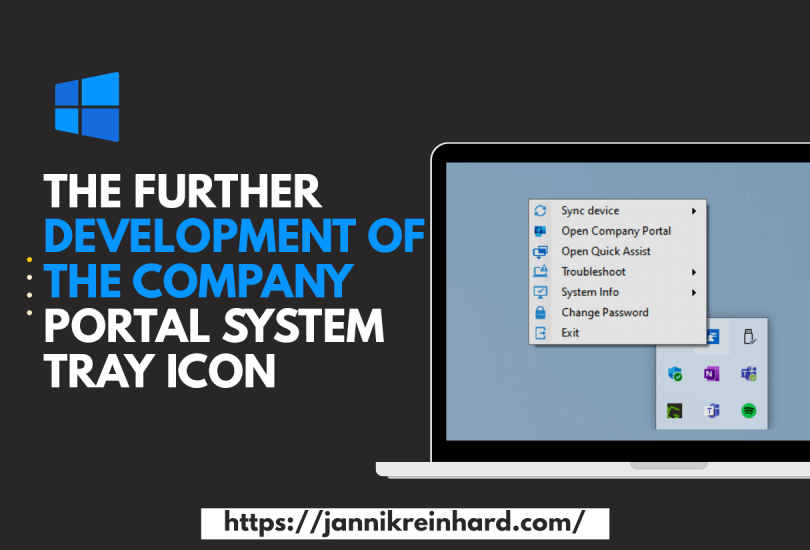A few weeks ago I released the Company Portal System Tray tool. The posts have a very good feedback and the tool was tested by some and also used productively. I have been working on developing the tool further and integrating more useful functions that can help with troubleshooting. The first version of the Company Portal system tray icon has many quick access possibilities to system tools or logs that are important for troubleshooting an Intune managed device. In addition, this tool has a quick access to open the Company Portal.
In this blog I want to introduce the new version of the Tool.

The new Features
Sync device
In the previous version there was only the possibility to sync app. In this version there is also the possibility the device compliance state.

Open Quick Assist
There is a button to open quick assist to connect remotely to the device. If you use an other remote support tool you can also change this to team viewer or any desk.

Get System Info
In this version is a menu with all important system information that can be important for supporting the device. You can see here for example the hostname, the IP, if the device is MDM managed and many more information. It is also not a big deal to add here more important informations.

Change the Password of the login user
You will also find in the company portal system tray tool a quick access to change the password of the logged in user.


How to deploy the tool
In the version 1.0 of the Company Portal System Tray Icon the tool was deployed via a PowerShell script. In V2 I have decided to deploy the tool via a Win32 because it is better located in Apps as in scripts. This also simplifies the integration into your environment. Now I will explain how you can deploy the app:
- Download the intune.win file from my repository or create a own intune.win file based on the files in my repository. How to create a intune.win file is explained in this blog post.
- Open the MEM Portal
- Navigate to Apps -> Windows
- Click Add
- Select Windows app (Win32) as App type

- Click Select app package file
- Click upload und select the .intunewin file
- Click OK

- Give the application a name and customize the app information.
- Click Next

- Enter install.bat and deinstall.bat as install/unistall command
- Change the Device restart behavior to No specific action
- Click Next

- Select 32-bit and 64-bit as Operation system architecture
- Select a minimum OS Version
Hints: If you want to specify further requirements, such as minimum free disk space, you can do this in this step.
It is also possible to specify a file, a registry value or a script as a requirement.

- Select Manually configure detection rules as Rules format
- Click Add
- Select File as Rule type
- Enter “C:\Windows_Tools\” as file path and “IntuneSystemTrayV2” as folder.
- The detection method is File or folder exists
- Click Next

- Skip the depentencies and supersedence step click next.
- Click Next

- Click Create

Conclusion
I hope I could help you with this little tool to simplify the troubleshooting process for the end user or to enable the end user who calls the support hotline to give more specific checks and answers. If you have ideas what I can add to the tool then let me know, I’m happy about any idea. You also have the possibility to add your own actions or checks that are specific to your environment.
Stay healthy, Cheers
Jannik


Hi @Jannik,
This looks great! Thanks for taking the time to build this. We are testing it out and seem to have run into an issue. Installing via InTune fails with an error that detection fails. Though no files are copied. Windows 10 19045 Build. Any suggestions?
Best,
Peter
LikeLike
The Detection should be C:\Windows\_Tools
LikeLike